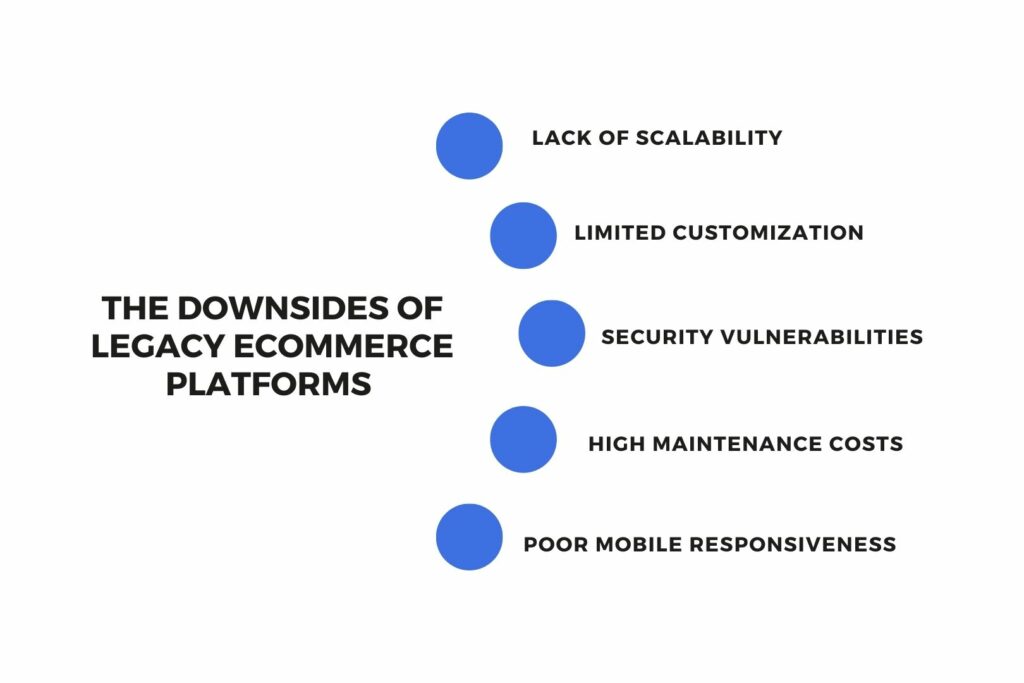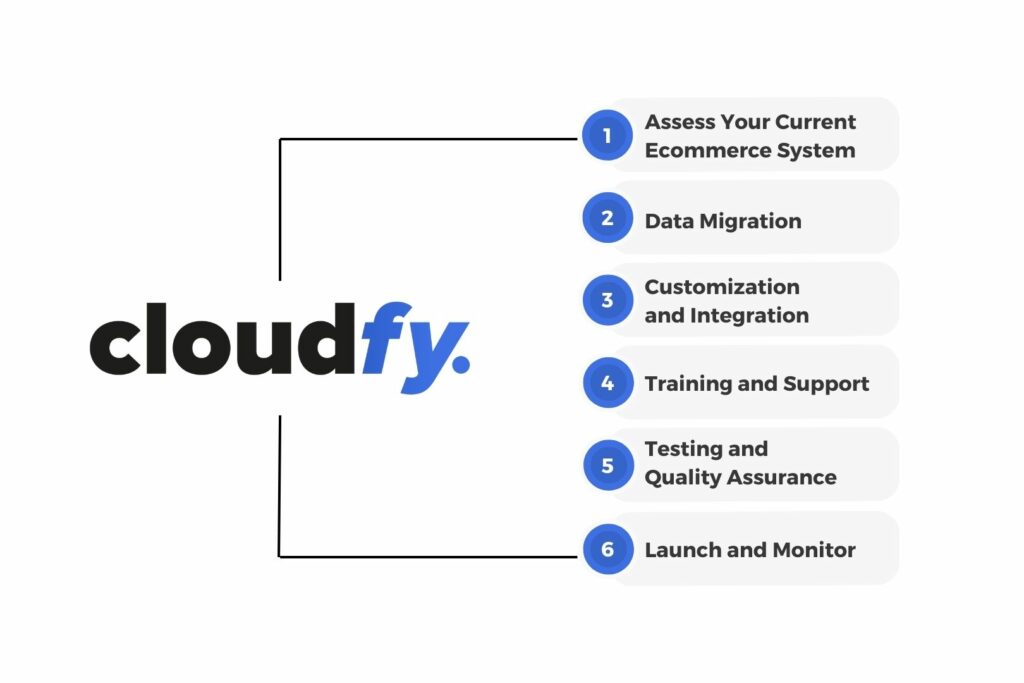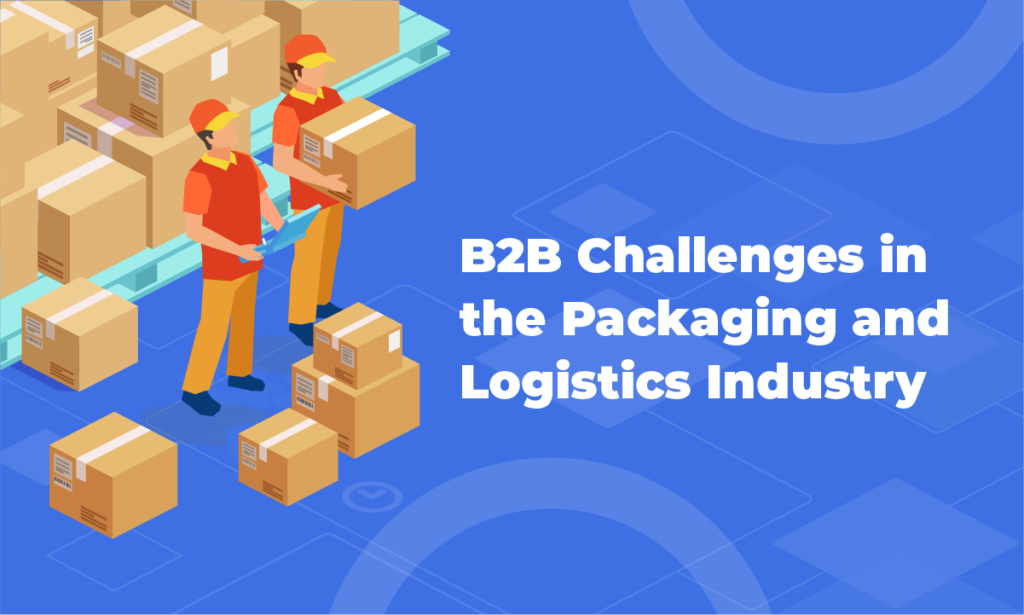In today’s fast-paced digital landscape, ecommerce has become the backbone of countless businesses, driving revenue, reaching global markets, and ensuring customer satisfaction. However, many companies find themselves constrained by outdated legacy ecommerce platforms that hinder their growth and flexibility. To stay competitive and relevant, businesses are increasingly turning to modern, cloud-based solutions like Cloudfy. In this blog post, we’ll explore the reasons for replacing legacy ecommerce platforms and the benefits of making the switch to Cloudfy.
Table of Contents

The Downsides of Legacy Ecommerce Platforms
Legacy ecommerce platforms, while once reliable and innovative, are now often burdened by limitations that can impede a company’s growth and competitiveness in the digital market. Here are some of the common drawbacks of legacy systems:
Lack of Scalability
Legacy platforms are notorious for their lack of scalability. As your business grows, your platform should be able to keep up with increased traffic and transaction volumes. Legacy systems, however, struggle to adapt to these changes. This can lead to performance issues, slower load times, and, in some cases, crashes during peak traffic periods.
Limited Customization
Legacy systems are typically rigid and limited in terms of customization. Businesses need to adapt and evolve quickly to stay competitive, and legacy platforms often lack the flexibility required to make necessary changes, whether it’s the user interface, payment processing, or integration with third-party tools.
Security Vulnerabilities
As technology evolves, so do the tactics and tools of cybercriminals. Legacy platforms are more susceptible to security breaches due to outdated security protocols and a lack of regular updates and patches. This can lead to data breaches and a loss of customer trust, which can be hard to regain.
High Maintenance Costs
Maintaining and supporting legacy systems can be costly, particularly if you’re paying for custom development or specialized support. The costs of maintaining outdated infrastructure and software can quickly add up, eating into your profitability.
Poor Mobile Responsiveness
In the age of mobile commerce, having a responsive and mobile-friendly ecommerce platform is essential. Legacy systems often struggle to provide an optimal mobile shopping experience, which can lead to a loss of potential customers who prefer to shop on their smartphones and tablets.
Cloudfy: A Modern Ecommerce Solution
Cloudfy is a contemporary, cloud-based ecommerce platform designed to address the limitations of legacy systems. It offers a range of features and benefits that can help businesses thrive in the highly competitive ecommerce landscape. Here’s why Cloudfy is a compelling choice for replacing legacy ecommerce platforms:What are your top considerations when you are thinking about upgrading or replacing your ecommerce platform?
Here are five things we recommend you think about before taking your next steps
Flexibility
Innovation in Cloud-based B2B ecommerce is outstripping the capabilities of many legacy and on-premises systems. The demand for improved user experiences, support for multi-tier selling, advanced pricing and order workflows are all driving improvements that can be developed and deployed quickly in the Cloud.
The most successful B2B companies are using scalable Cloud-based ecommerce platforms to support their new strategies.
Staying agile
Manufacturers and wholesalers who rely on in-house systems and historically complex business processes are limiting their sales channels and missing the mark on user experiences.
Innovation and improvement is achieved by collecting, testing and analyzing data, which is not always easy with older ‘silo’ business systems. Powerful application programming interfaces are making it far faster to develop new ideas and test them in the Cloud.

Going beyond pricing
Price and availability are important for B2B buyers and they are looking for consistency across online and offline channels. However, many ecommerce innovations around pricing are likely to be beyond the scope of older systems.
For example, it is becoming essential for many businesses to tailor pricing, currencies and languages for complex product lines and multiple sites. Performance can be dramatically improved by responding to real-time supply and demand with dynamic price adjustments. Many manufacturers are adding value and gaining a distinctive market position by offering configure, price, quote (CPQ) selling across multiple channels.
Distinctiveness
B2B buyers expect their buying experience to be comparable to shopping on Alibaba or Amazon. However, that doesn’t mean they want to make their business purchases in those marketplaces.
Forward-looking B2B ecommerce companies are doing much more than simply delivering these user experience essentials. They are using their knowledge and understanding of their sector and customers to create a personalized and tailored service.
They are improving satisfaction and building customer loyalty by using buying histories and customer preferences and by delivering bespoke online specifications and quotations. To do this they need integration with back-office systems.
Supporting this with quality content and technical and customer support helps to make them the supplier of choice.
Cost efficiency
Features such as improved catalogue management, flexible storefronts, partner portals, CPQ and payment gateways are quickly becoming essential. It can be time-consuming and costly to develop these features in older systems.
Where business systems have been developed independently manual processing and human errors can easily affect performance and buyers’ satisfaction.

Making the Switch to Cloudfy
Now that we’ve explored the benefits of Cloudfy, let’s discuss the steps involved in replacing your legacy ecommerce platform with this modern solution:
Assess Your Current Ecommerce System
Start by thoroughly assessing your existing ecommerce platform. Identify its strengths and weaknesses, and document your business’s specific requirements. This will help you determine the functionalities you need from Cloudfy and any customizations necessary for a seamless transition.
Data Migration
Migrating data from your legacy system to Cloudfy is a crucial step. Depending on the complexity of your current setup, this process can vary in scope and complexity. Cloudfy’s experts can assist with data migration to ensure a smooth transition without data loss.
Customization and Integration
Leverage Cloudfy’s flexibility to customize your new ecommerce platform to align with your brand and business needs. If you have existing third-party integrations, Cloudfy can accommodate those, ensuring a seamless flow of data and operations.
Training and Support
As you transition to Cloudfy, it’s essential to provide training for your team to ensure they can efficiently use the platform. Cloudfy offers training resources and support to help your staff become proficient in managing and optimizing your ecommerce site.
Testing and Quality Assurance
Before going live with your new platform, thoroughly test all aspects of your ecommerce website to ensure that it functions correctly, performs well, and is secure. This step is critical to avoiding any issues that might negatively impact your customers’ experience.
Launch and Monitor
Once you’re confident in your Cloudfy setup, it’s time to launch your new ecommerce platform. Continuously monitor its performance and gather feedback from users to make further improvements.
In the ever-evolving world of ecommerce, businesses must adapt to survive and thrive. Replacing legacy ecommerce platforms with modern, cloud-based solutions like Cloudfy is a strategic move that can provide your business with scalability, customization, security, cost-efficiency, and mobile responsiveness. As you contemplate this transition, it’s essential to conduct a comprehensive assessment of your current system, plan for data migration, customize your new platform, provide adequate training and support, and thoroughly test before going live.
By making the leap to Cloudfy, your business can stay ahead of the curve, deliver an exceptional online shopping experience, and unlock new opportunities for growth and success in the digital marketplace.
Modern Cloud-based B2B Ecommerce platforms include order management and come with integration for major business systems. They provide a unified view across sales channels and reduce costs at the same time. They can scale to support ‘just in time’ (JIT) availability, automate replacement orders and customize complex workflows.
For expert advice on your next ecommerce steps contact us now to discuss.
Frequently Asked Questions
Legacy ecommerce platforms often suffer from scalability issues, limited customization, security vulnerabilities, high maintenance costs, and poor mobile responsiveness.
Cloudfy is a modern, cloud-based ecommerce solution that offers scalability, customization, top-notch security, cost-efficiency, and mobile responsiveness, addressing the limitations of legacy systems.
The steps include assessing your current system, migrating data, customizing and integrating Cloudfy, providing training and support, testing, and quality assurance, and finally, launching and monitoring the new platform.
Cloudfy supports B2B ecommerce by offering flexibility, agility, advanced pricing options, personalized user experiences, and cost-efficient features. It enables B2B companies to meet the demands of modern buyers effectively.
Yes, Cloudfy can accommodate existing third-party integrations, ensuring a seamless flow of data and operations within your ecommerce ecosystem.





